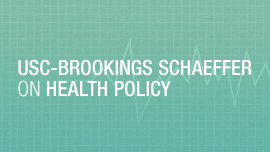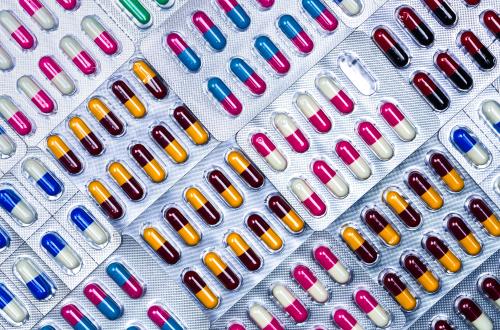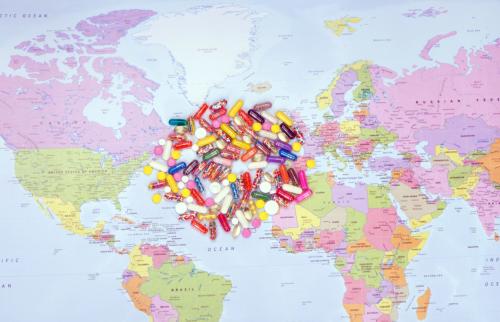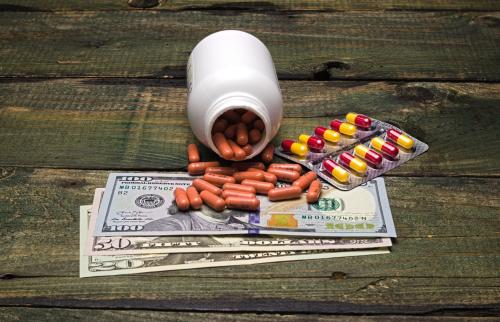This analysis is part of the USC-Brookings Schaeffer Initiative for Health Policy, which is a partnership between Economic Studies at Brookings and the University of Southern California Schaeffer Center for Health Policy & Economics. The Initiative aims to inform the national health care debate with rigorous, evidence-based analysis leading to practical recommendations using the collaborative strengths of USC and Brookings. The Commonwealth Fund has provided a grant to the Brookings Institution to support the work on which this post is based. Part 1 of this two-part blog originally appeared in Health Affairs on November 24, 2020. Part 2 was posted in Health Affairs on November 25, 2020.
Most Americans believe U.S. prescription drug prices are too high—a conclusion reinforced by almost 3 in 10 Americans reporting they go without prescribed medications because of cost. Indisputably, Americans pay much higher prices for brand-name drugs than people in other industrialized nations. Despite viewing drug prices as too high, most Americans value innovation, believing that new drugs improve people’s lives.
On November 20, 2020, the Trump Administration issued two rules intended to lower drug prices paid by Medicare beneficiaries. The rule affecting Part B institutes a “most favored nation” provision limiting prices (generally for physician administered drugs) to the lowest price available in another country. The rule affecting Part D reforms, for drugs purchased at retail pharmacies, certain discounts (known as rebates) that flow to health plans after patients have paid for their prescriptions.
The high prices U.S. patients pay for drugs are a key driver of pharmaceutical company financial performance, generating large profits relative to many other industries and an estimated three-quarters of worldwide drug company profits. As a result, lowering U.S. drug prices would likely have an outsized impact on overall incentives to innovate. The prospect of large profits, which translate into high returns on investment (ROI), attracts the private capital that finances pharmaceutical innovation. U.S. pharmaceutical companies invested an estimated $80 billion in 2018 in drug research and development (R&D), and such spending yielded an annual average of 44 new drug approvals from 2015 to 2019, although 47 percent are “orphan drugs,” meaning that very few patients will benefit from them. The Food and Drug Administration (FDA) designated almost half of the new drugs in this period as “first in-class,” and over a quarter as “breakthrough” therapies.
Lowering high U.S. drug prices will make investing in drug development less attractive for private capital, leading to fewer new medicines coming to market. Balancing the tension between lowering U.S. drug prices while sustaining robust R&D investment poses a complex challenge for policymakers and raises the fundamental question addressed in this two-part blog post: how can the U.S. minimize the adverse effects of lower drug prices on innovation?
To inform this question, the USC-Brookings Schaeffer Initiative for Health Policy, with support from the Commonwealth Fund, convened a roundtable of experts in June 2020 to explore how to minimize disruption of important innovation while designing effective policies to reduce U.S. drug prices. Current and former pharmaceutical and biotech executives, physician/scientist entrepreneurs, private equity and venture capitalists, and economists participated. Because the session was off the record to encourage people to speak freely, we convey the meeting’s general content without attributing specific comments. We are grateful for their participation, but in keeping with our commitment to keep the meeting off the record, we do not list the individuals.
In part 1 of this post, we provide background about why U.S. drug prices are higher than in other developed countries and summarize the roundtable discussion about the relationship of drug prices and innovation as well as limitations of the current U.S. market-based approach to drug pricing in fostering transformational rather than incremental innovation.
Background: Why U.S. Drug Prices Exceed Other Nations’
Unlike other developed nations, the United States does not extensively regulate the price of prescription medicines, instead relying primarily on market forces to determine prices. Competition generally works well for generic drugs, for which market exclusivity has ended, but not for brand (innovator) drugs. Many generic drugs have competing products made by multiple manufacturers and reflect commodity pricing. Despite accounting for 90 percent of 5.8 billion U.S. outpatient prescriptions in 2018, generic drugs comprised only 20 percent of drug spending, averaging just $19 per prescription. In contrast, the 10 percent of prescriptions for brand drugs constituted almost 80 percent of outpatient drug spending in 2018, with an average price at the pharmacy of $428 per prescription. A subset of brand drugs—biologic or specialty drugs—comprised only 2.2 percent of outpatient prescriptions but accounted for half of outpatient drug spending.
Single-source brand drugs are insulated from competition by government-granted monopolies based on patents, data exclusivity protections (that prevent potential competitors from relying on an innovator’s data), or other FDA requirements. Market exclusivity severely limits competition as an effective force to lower prices for many brand drugs, especially in cases without effective therapeutic alternatives. Unlike normal markets where high prices limit demand, which tends to constrain prices, having third-party insurance pay most of the cost of prescription drugs largely insulates patients from high prices. As a result, high prices have minimal effect on demand—especially for potentially life-saving or life-altering treatments.
Cost Of Developing New Drugs
The mean cost of developing a new drug is $1.3 billion, with a median cost of $985 million, although estimates range from $314 million to $2.8 billion. These estimates include the costs of development efforts that did not succeed in producing a marketable drug.
Marketing
Pharmaceutical manufacturer revenues are driven by price and quantity. As a result, manufacturers of brand drugs have historically invested heavily in marketing to increase sales. Marketing expenses in 2016 included $13.5 billion to provide free drug samples to clinicians, $6 billion for direct-to-consumer (DTC) advertising, $5 billion for “detailing” (in-person visits by sales representatives with clinicians and their staff), $1 billion on payments to physicians and hospitals for non-research activities, and $119 million on medical journal advertising.
Of the 37 Organization for Economic Co-operation and Development nations, only the United States and New Zealand allow DTC advertising of prescription drugs. Although first appearing in the U.S. in the 1980s, liberalized FDA requirements in 1997 spurred manufacturers to increasingly rely on DTC advertising for prescription drugs. A recent study found that the number of ads has grown exponentially, from 79,000 in 1997 to 4.6 million in 2016, including 663,000 television commercials. DTC advertising seeks not only to divert sales from competitors but also to generate greater consumer interest in drugs that have no competitors.
Formularies, Pharmacy Benefit Managers, And Rebates
Most U.S. health plans cover outpatient prescription drugs through a distinct pharmacy benefit separate from coverage of medical services like physician and hospital care. Health plans typically contract with pharmacy benefit managers (PBMs) to negotiate drug prices with manufacturers and process prescription claims. PBMs and the payers that retain them use drug formularies—or a list of brand and generic prescription medications they cover—combined with patient cost-sharing requirements and utilization management techniques, such as prior authorization, to help restrain drug prices. Formularies commonly have tiers with different out-of-pocket costs for patients based on, for example, whether a drug is a generic, a preferred brand, or a nonpreferred brand.
Health plans and PBMs use pharmacy and therapeutics committees composed of clinical experts to decide on the coverage and tier placement of drugs. These committees initially make decisions based on clinical factors, after which they take costs into account. Manufacturers typically negotiate with PBMs for favorable formulary placement, offering discounts from the list price of a drug.
Brand manufacturers also pay rebates to health plans—price concessions paid after a patient purchases a drug—with the resulting net prices considered confidential, trade secrets. Rebates are, for the most part, discounts designed to shift volume toward the drug in question, rather than wasteful spending retained by intermediaries, such as PBMs, and are particularly important in drug classes with multiple competing therapeutic alternatives. In Medicare Part D and many commercial health plans, rebates lower overall costs for the insurer and thus premiums, but not what a patient pays out of pocket when purchasing a brand drug. In an attempt to lower the cost-sharing paid by patients in Medicare Part D, the Trump Administration’s November 20 final rule eliminates the “safe harbor” that protects manufacturers offering post-sale rebates on brand drugs (but permits discounts that lower point-of-sale prices). Analysts differ not only on the potential magnitude of savings but also on whether eliminating rebates or requiring a portion of rebates to lower patient out-of-pocket costs would reduce or increase drug spending. Regardless of the effects on drug spending, eliminating or redirecting rebates would increase overall costs paid by insurers by turning off the revenue stream from rebates.
Roundtable Consensus
Steep, Across-The-Board Price Cuts Would Reduce Innovation
Given the United States’ distinct role in pharmaceutical R&D, roundtable participants confirmed the conventional wisdom that illustrative cuts averaging either 20 percent or 40 percent in net U.S. drug prices would sharply reduce innovation. “It’s clear that innovation is the most fragile part of the whole system, and to put draconian cuts of 40 percent across the board and think it’s going to solve the problem [of high health care costs] is going to destroy something very valuable,” one expert participant said, reflecting a widely held view among participants.
Acknowledging that “there probably are some indications where a 20 or 40 percent cut in prices allow the economics of developing a drug to still work,” another participant said in most cases such a scenario would have a chilling effect on start-up companies. The calculus of investing in a new drug candidate is typically pretty straightforward: Will the number of patients who can benefit be large enough and the price high enough to recoup the costs of bringing the drug to market? If the numbers don’t add up, venture capital will go elsewhere, the participant said, an assessment widely shared by participants.
Others predicted that sharp price cuts would spark another wave of consolidation among drugmakers where, in the words of one participant, “the companies [could] end up being pretty much a marketing and sales organization and abandoning R&D, at least for a period of time until there is some recognition that there is need for more innovation.” Several participants noted the steep decline over the past several decades in R&D by European pharmaceutical companies, which they tied to low drug prices. In contrast to other developed countries, which essentially all use established and predictable processes to price drugs, the ongoing uncertainty in the U.S. about drug pricing—much of it political in nature—threatens innovation, participants agreed.
Incremental Versus Transformational Innovation
Participants expressed concern that current U.S. drug pricing practices and incentives lead to suboptimal results from a societal perspective, reinforcing incremental innovation, or advances that target small populations, rather than innovation that can broadly improve population health. Participants widely shared that they weren’t “entirely comfortable with the alignment of value and price” under the status quo, worrying that “certainly there’s evidence out there, suggesting that a lot of the new drugs have relatively small advantages over the existing cohort.” However, the achievement of only modest therapeutic advances might reflect the difficulty and uncertainty of drug development.
The current system arguably does not direct R&D funding to potentially transformational innovation that more broadly improves population health. Instead, current incentives tend to reward new oncology drugs offering only modest therapeutic advances with high prices, and drugs developed for rare diseases—so-called orphan drugs—with both high prices and extended market exclusivity. One expert noted that when there are only 1,000 or 10,000 potential patients for a drug, and R&D costs are still hundreds of millions of dollars, “deploying a price at a higher amount to make a real market to recoup that cost is the only way it works.” However, some orphan drugs subsequently receive approval for treating broader populations.
Without an expectation of receiving high prices, such as for oncology and orphan drugs, participants generally agreed with the observation that there’s been limited innovation in the category of “general medicine,” which includes treatments for conditions like heart disease and diabetes and anti-infectives like antibiotics. As one participant observed, “I think we’re failing in terms of the opportunity to improve overall health.” However, it was noted that the COVID-19 pandemic has altered the landscape for anti-infectives, at least for the immediate future.
Another participant explained that from a capital investment standpoint, currently there’s just not enough potential ROI in developing drugs that might benefit society more broadly. A third participant cited the example of cardiovascular disease, stating it’s “getting less and less attractive from an investment perspective because of pricing and reimbursement pressure,” concluding, “It’s just really sad.”
A significant factor affecting incentives for developing new medicines is whether effective and inexpensive generic drugs are available that treat many of these conditions. Reflecting innovation that occurred years earlier, the availability of effective generic therapies means expensive new drugs likely will be limited to the subset of patients for whom standard treatments do not work. To some extent, a slowing of innovation in areas where highly effective drugs have been developed may reflect a natural part of a cycle.
More broadly, participants observed that pharmaceutical companies are highly responsive to incentives, such as those that currently exist for orphan drugs, oncology drugs, and specialty biologic drugs for autoimmune disorders. Participants urged policymakers to think carefully about designing strategies to lower drug prices: “Because what is spared [from the consequences of having ROI lowered] will become the new focus,” a participant said. “If it’s cell and gene therapy that’s spared, then that will become the focus.”
Additional Roundtable Insights
Part 2 of this post, to be published tomorrow, provides an overview of additional insights from the roundtable discussion about how to lower drug prices while minimizing adverse impact on innovation, including lowering drug development costs, increasing the share of revenues flowing to drug manufacturers by minimizing marketing and rebate costs, and creating better measures of the value of pharmaceutical innovation.
-
Acknowledgements and disclosures
We are grateful to Tamara Hayford for advising on the design of the roundtable and providing comments on a draft of this blog and for the assistance of Alwyn Cassil.
The Brookings Institution is committed to quality, independence, and impact.
We are supported by a diverse array of funders. In line with our values and policies, each Brookings publication represents the sole views of its author(s).








Commentary
Balancing lower U.S. prescription drug prices and innovation – Part 1
November 24, 2020